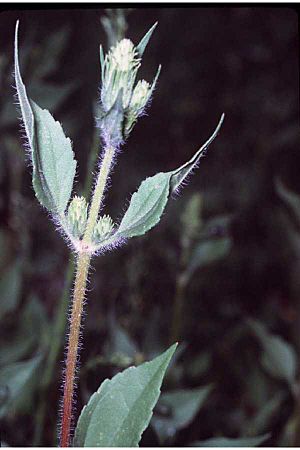Annual marsh elder facts for kids
Quick facts for kids Iva annua |
|
|---|---|
 |
|
| Scientific classification | |
| Kingdom: | |
| (unranked): | |
| (unranked): | |
| (unranked): | |
| Order: | |
| Family: | |
| Genus: |
Iva
|
| Species: |
I. annua
|
| Binomial name | |
| Iva annua L. 1753
|
|
| Synonyms | |
|
|
Iva annua, also known as the annual marsh elder or sumpweed, is a plant from North America. It's a type of herb that grows for one year. This plant belongs to the sunflower family. Long ago, Native Americans grew it for its seeds, which they could eat.
Contents
About the Sumpweed Plant
Iva annua is an annual herb. This means it grows and dies within one year. It can grow quite tall, up to about 150 centimeters (5 feet). The plant has many small flowers. These flowers grow in a narrow, spike-like shape. Each flower head has 11 to 17 small disc florets. It does not have the larger ray florets that you see on a typical sunflower.
Where Sumpweed Grows
This plant is native to parts of North America. You can find it in northeastern Mexico, especially in the state of Tamaulipas. It also grows in the central and southern United States. It is common in the Great Plains and the Mississippi Valley. Its range goes as far north as North Dakota. Some populations of Iva annua are found in the eastern United States. However, these plants likely grew there after being brought from other areas.
How People Used Sumpweed
An Ancient Crop
About 4,000 years ago, Native Americans started growing Iva annua. They grew it for its edible seeds. This was part of a farming system called the Eastern Agricultural Complex. Sumpweed was very important to the people of the Kansas City Hopewell culture. These groups lived in what is now Missouri and Illinois.
Nutritional Value
The seeds of Iva annua were very nutritious. They contained a lot of good things for people. About 32 percent of the edible parts were protein. Also, about 45 percent of the seeds were oil. This made them a valuable food source.
Why It Was No Longer Grown
Even though sumpweed was nutritious, it had some downsides. Like its relative, ragweed, sumpweed can cause strong allergic reactions in some people. It also had a rather unpleasant smell. Because of these reasons, people eventually stopped growing it. When new crops like maize (corn) became available, they were much more pleasant to grow and eat. By the time Europeans arrived in the Americas, Iva annua was no longer a common crop.

